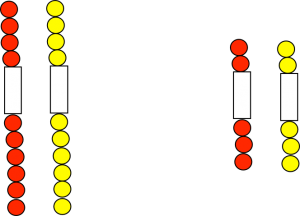Mitosis Simulation with Pop-it Beads
Pop-beads are small, colored beads that can be joined together to simulate chromosome strands. We will use the pop-it beads to simulate the process that chromosomes undergo during cell division. Imagine that the beads represent long stretches of DNA that comprises the genetic instructions for the cell. Start with a cell with a chromosome number of 4 (4 chromosomes, or 2 homologous pairs). We will use red to identify the chromosome from the mother and yellow for the chromosome from the father.

- Make 4 chromosomes: two long chromosomes (one red and one yellow) and two short chromosomes (one red, one yellow). The two long chromosomes should each have the same number of beads, as should the two short chromosomes. The two long chromosomes are one homologous pair; the two short chromosomes are the second homologous pair.
- Simulate S phase: Replicate your chromosomes by making an identical set of pop-it bead chromosomes (you should have a total of eight pop-it bead strands; four long and four short). Attach the identical replicas (chromatids) by their magnetic centromeres.
- Simulate Mitosis: Move the “chromosomes” through each of the four stages of mitosis. Draw and label the pop- bead chromosomes for ONE of the phases on a separate sheet. (It is not necessary to draw each individual bead.)
- Draw a large circle on the paper to represent the cell and the nucleus with a pencil.
- Place your chromosomes in this an walk through each stage of Meiosis.
- Erase the outlines as you go along and re-draw the boundaries of nuclei.
- Document each stage with your cell phone
- Prophase
- Metaphase
- Anaphase
- Telophase


